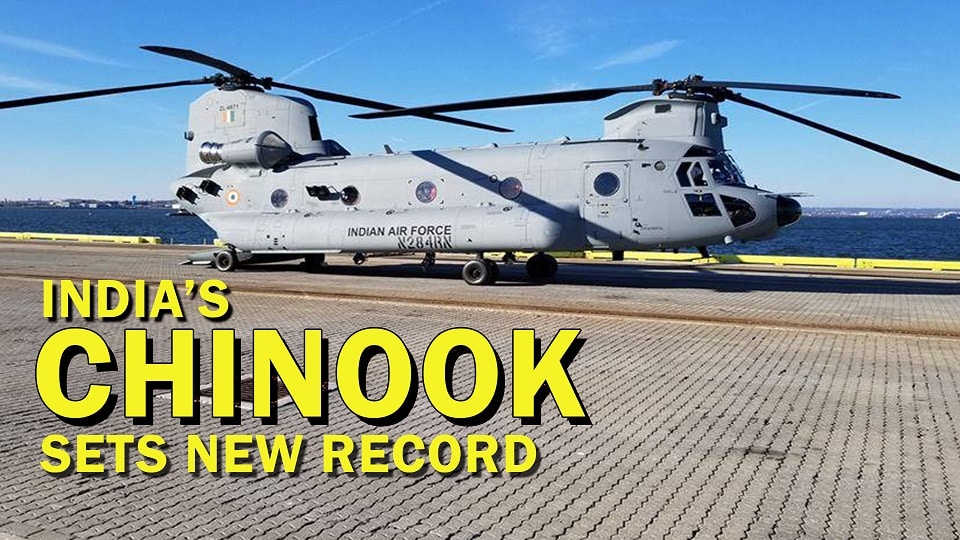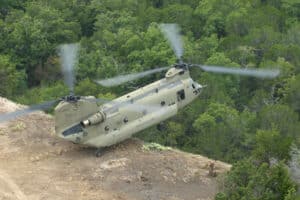Aerospace
India’s Chinook Helicopter Creates A New Unique Record

The Chinook helicopter is one of the world’s strongest and most battle-tested helicopters, and it is mostly employed for military supplies. India recently set a new record with the Chinook. The Indian Air Force operates these helicopters.
In a first, the Indian Air Force’s heavy load transport helicopter, the Boeing-built Chinook, set a new record for the longest helicopter journey in India. The newly acquired Indian Air Force aircraft set a new record for the longest non-stop helicopter sortie, flying from Chandigarh to Jorhat, Assam. According to IAF officials, the chopper took seven and a half hours to accomplish the 1910 kilometer voyage.
The Indian Air Force has purchased Boeing-made Chinook helicopters to modernize its fleet, as well as Apache attack helicopters. The Chinook is a vertical-lift multi-role platform that transports troops, artillery, equipment, and fuel. It’s also employed in humanitarian and disaster relief operations, as well as tasks like relief supply transportation and mass refugee evacuation.
In September 2015, India signed a contract with the United States to buy 22 Apache helicopters and 15 Chinook helicopters for roughly USD 3 billion.
The first four CH-47F Chinook helicopters for the Indian Air Force arrived ahead of time at the Mundra Port in Gujarat on February 10, 2019.
In a 241 km/hr flight, it uses 329 gallons (1245 litres) every hour. It has a maximum flight time of 7 hours and 850 nautical miles or 1574.2 km distance (when equipped with two ER tanks). 23.133 kgs is the maximum gross weight.
However, according to a recent report from the Indian army, the range of the constraints has been exceeded. This is flown to a distance of 1910 kilometres.
It’s available as a brand-new engine or as a replacement for the T55-714A engine that powers the majority of the world’s C-47 Chinook fleet.
India formalises acquisition of 56 Airbus C295 aircraft
The Chinook is one of only two military aircraft developed in the 1960s still in production and service after 50 years – the other is the C-130. The new T55-714C engine offers 25% better reliability, carries a 22% heavier payload and provides an 8% improvement in fuel efficiency.
| CONFIGURATIONS | EFFICIENCY | RANGE |
| Firefighting Passenger Transport Cargo MEDEVAC |
Large Ramp for Cargo and Passengers |
Up to 7 Hours and 850 Nautical Miles (when equipped with two ER tanks)
|
| PAYLOAD | POWER | SPEED |
| Maximum Gross Weight 51,000 lbs (23,133 kgs) | Two Honeywell AL5512 Engines | Maximum Speed 150 kts or Cruise Speed 120 kts |
The CH-47 is the “workhorse” of the United States Army’s helicopter fleet. Multiple doors across the fuselage, a broad loading ramp at the back of the fuselage, and three exterior hooks to handle underslung items are all available for loading cargo on the Chinook.
Anti-Tank Guided Missile ‘HELINA’ successfully flight tested
Unmatched in range, endurance, and heavy-lift mission capability, the 234 Multi-Mission Chinook is a year-round workhorse that can be quickly reconfigured to meet multiple mission profiles, expanding the aircraft’s economic efficiencies and return on investment.
How powerful is the J10 Pakistan’s new Fighter jet ?
#Chinook #Boeing #IAF

Aerospace
Boeing Transfers Rocket Stage to NASA, Paving Way for Human Moon Mission

Boeing has achieved a significant milestone by providing NASA with the second core stage of the Space Launch System (SLS) rocket.
This crucial component, crafted at NASA’s Michoud Assembly Facility (MAF), is set to propel the Artemis II crew into lunar orbit, marking humanity’s return to deep space after a 50-year hiatus.
The monumental Boeing-built rocket stage, the largest element of the Artemis II mission, will embark on a journey aboard the Pegasus barge, traveling 900 miles to NASA’s Kennedy Space Center.
Comparison of two legendary aircraft B777x vs B747 aircraft:Click here
Upon arrival, it will be meticulously integrated with other essential Artemis II components, including the upper stage, solid rocket boosters, and NASA’s Orion spacecraft within the iconic Vehicle Assembly Building. This intricate integration process is a vital step toward the eagerly anticipated Artemis II launch, slated for 2025.
“Boeing-built products helped land humankind on the moon in 1969, and we’re proud to continue that legacy through the Artemis generation,” remarked Dave Dutcher, vice president and program manager for Boeing’s SLS program. “Together, with NASA and our industry partners and suppliers, we are building the world’s most capable rocket and paving the way to deep space through America’s rocket factory in New Orleans.”
NASA, Lockheed Martin Reveal X-59 Quiet Supersonic Aircraft:Click here
The delivery of Core Stage 2 marks a significant achievement in the evolution of the SLS rocket. Towering over 200 feet and powered by four RS-25 engines, this core stage, coupled with two solid-fueled booster rockets, will generate a staggering 8.8 million pounds of thrust. This immense power is crucial to launching Artemis II and future missions into the vast expanse of space.
The SLS rocket stands unparalleled in its capability to transport both crew and substantial cargo to the moon and beyond in a single launch. Its extraordinary capacity will facilitate the delivery of human-rated spacecraft, habitats, and scientific missions to destinations including the moon and Mars, ushering in a new era of space exploration.
-

 Travel1 week ago
Travel1 week agoAir India to Expand US Operations with Three New Routes After a Decade
-

 Travel2 weeks ago
Travel2 weeks agoWhy We Should Avoid These Stamps in a Passport
-

 Airlines1 month ago
Airlines1 month agoInvestigations Reveal Fake Chinese Titanium in Boeing and Airbus Jets
-

 Tech4 weeks ago
Tech4 weeks agoChina’s CATL Plans 1,800-Mile Electric Plane Launch by 2027
-

 Airport3 days ago
Airport3 days agoTop 10 Largest Airports in the World by Size
-

 Aerospace4 weeks ago
Aerospace4 weeks agoChina’s Fighter Jets Turn Wings into Autonomous Drones
-

 Airlines4 days ago
Airlines4 days agoAir India Rolls Out A350s for Delhi-New York JFK and Newark Routes
-

 Defence3 weeks ago
Defence3 weeks agoBoeing Enhances Chinook with New Engines and Block II Upgrades at $96 Million








